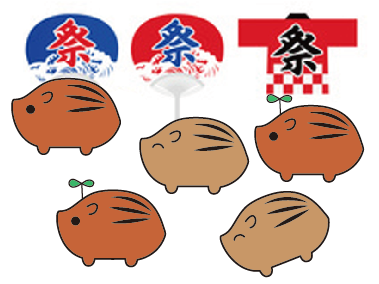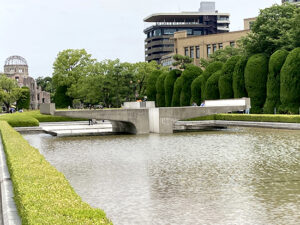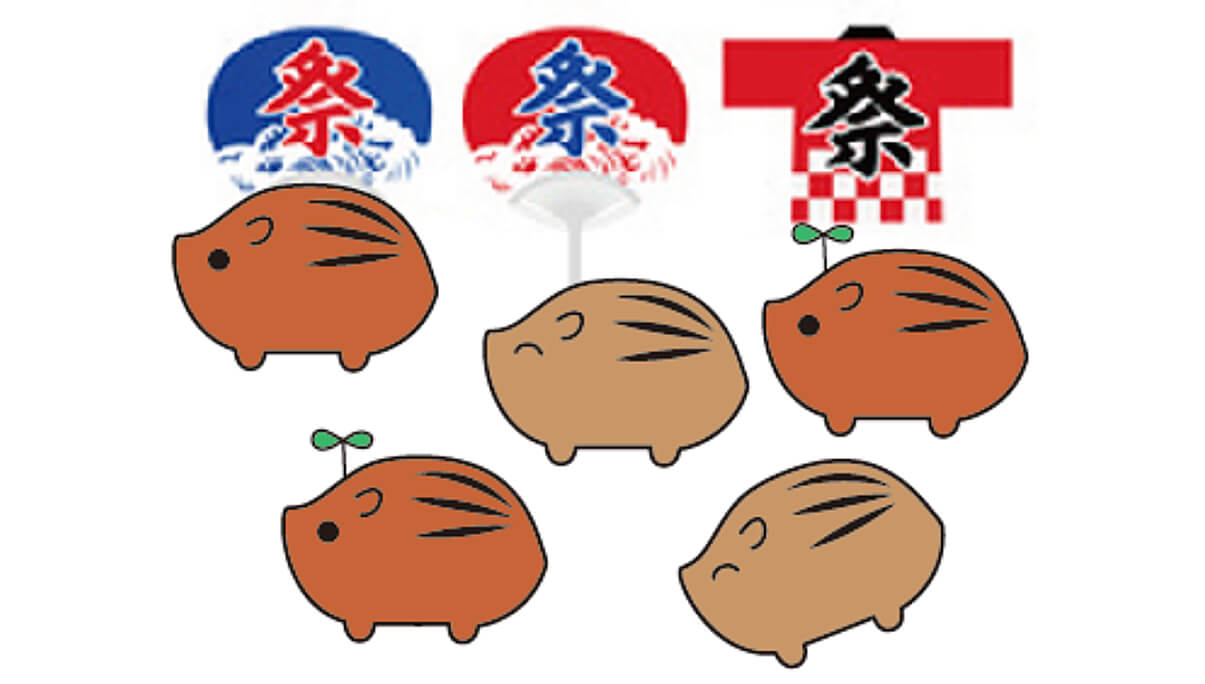In early November, the “Inoko Festival” is held here and there in Hiroshima City, where I live, and I can hear the cheerful voices of children parading through the town. This festival is held close to the first day of winter.
This festival celebrates the harvest and prays for the prosperity of offspring. As a Hiroshima native, I have been familiar with this festival since I was a child.
Today, I would like to talk about the Inoko Festival and its origin, focusing on the Inoko Festival I know about in Hiroshima.
I will share a video that was uploaded on YouTube.
As I will explain in a later section, this is a video of the Inoko Festa held in 2013, mainly in Noboricho Park in Hiroshima City. Here is what the Inoko I know so well looks like.
(You will hear the phrase “Inoko Inoko,” often used in Hiroshima, starting at about 1 minute and 40 seconds)
What is the Inoko Festival?
It is a festival held on the first Inoko day of the tenth month of the lunar calendar (around November today), and is still held mainly in western Japan.
In Hiroshima, children’s groups play a central role in the festival, and children parade through the town carrying a large stone with several ropes attached to it. At major locations, the children pound the ground with the stone while singing a song about the Inoko’s whelps.
In some places, Inoko mochi (rice cakes) are made and eaten, and the children who pounded the stones are sometimes given sweets by their families. (I don’t think this happens very often in Hiroshima.)

Inoko are said to be fertile, so this festival is a time to pray for prosperity of offspring, business, and health, as well as to give thanks for the autumn harvest.
When is the Inoko Festival?
The first Boar Day in November this year, 2020, is Wednesday, November 4.
Most festivals are held on Saturdays and Sundays, so I expect that many places will hold their festivals on Saturday, November 7 or Sunday, November 8 this year.
The festival is held in units of each neighborhood association or children’s association, so it is expected to be different in each case.
The “Great Inoko Festival” will be held on the city’s main street and in Fukuromachi Park, which will also probably be held on the 7th (Sat.) and 8th (Sun.).
Which regions have Inoko Festival?
According to our research, it is held in the Chugoku region, Ehime Prefecture, parts of Shiga Prefecture, and parts of Oita Prefecture. There may be others, but it still seems to be a festival that remains limited to parts of western Japan.
What is the origin of the Inoko Festival?
In ancient China, there was a custom of eating rice cakes mixed with grains at the time of the Boar’s Hour on the tenth day of the tenth month of the lunar calendar. It is widely believed that this custom came to Japan and was practiced by the nobility.
The rice harvest was just about over for farmers, and it seems to have had a meaning of celebrating the harvest as well.
What is Inokomochi?
All my life in Hiroshima, I have heard the phrase, “Inoko Inoko,Inokomochi, tsukiete” (“with rice cake for the Inoko”)…
Actually, I don’t remember eating “Inoko’s whelk rice cake”. (^_^;
I always wondered what a Inoko’s whelp rice cake was.
I found out that it could be a regular rice cake, a rice cake covered with boiled azuki beans, or a rice cake colored to resemble a wild boar, depending on the place.
It seems that the custom of eating the rice cake at the time of the boar’s hour (around 10 p.m.) on the day of the boar’s arrival was originally started among the nobles of the court during the Heian period (794-1185). The Inoko Festival was also an annual event of the Edo shogunate, and Inokomochi were sometimes distributed to officials by the shogun.
In Hiroshima, the Inoko Festival parade has always remained, but the rice cakes seem to have disappeared. I wonder how it is in other regions…?
Inoko’s whelps and kotatsu
In the Edo period, there was a custom called “Kotatsu-opening,” in which a kotatsu was opened for the first time on the day of the Inoko Festival. It was said that opening the kotatsu on this day would prevent a fire from breaking out, and it was also thought to be a day of good luck in combination with the Inoko Festival’s symbolic blessings of prosperity for offspring and good health. It is close to the first day of winter, and the mornings and evenings are beginning to feel a little colder.
Various Inoko Songs
The Inoko songs I know are
Inoko inoko inoko inoko inoko inoko no moichi tsukiete hanjosee hanjosee
(Boarling, boarling, pounding boarling rice cakes, prosperity, prosperity)
The phrase is repeated over and over again.
Inoko songs from other regions include
Inoko inoko inoko inoko mochi tsuki (Inoko cub, Inoko cub, pounding Inoko cub rice cake)
iwawanmono oni umeme jia umeme (Celebrate oni umeme, snake umeme)
tsunohano hatareta ko umeme (Horned cub)
(Some people say, “I am a snake, a snake, a snake, a snake.)
There is also “Tsuno no hatarete ko’ume (A horned child is born) (omitted).
In addition
A man named Inoko-san sprinkled straw all over the land, and then smiled and said, “Inoko, Inoko, Inoko, Inoko, Inoko!
Inoko, inoko, inoko no yoru osa
Mochikakeru ha, oni wo natte, snake wo natte, kakuro wo natte
Esa, hoisai, saikoro mochi wo ewase (omitted hereafter)
There is also a song called “Esa, hoisai, saikoromochi wo ewase (and abbreviated thereafter).
It is very interesting to see how many different songs remain in different regions.
This video is from Uwajima City, Shikoku, and is different from the Inoko Festival I know, but it is sung like a counting song. It is very interesting to see how different the songs are sung in different regions.
Hiroshima’s new Inoko Festival “Daiinoko Matsuri” (Great Inoko Festival)
As I mentioned at the beginning of this article, this festival has been held every year in Hiroshima by each neighborhood association or children’s association since I was a child (and probably even before) until now.
In the midst of all this, with the intention of making the Inoko Festival even bigger and more enjoyable for everyone, a new form of Inoko Festival, the “Dai Inoko Matsuri,” has been held at Fukuromachi Park in the city’s Naka Ward since 2014.
Please take a look at the video of the 2013 Inoko Daifuku Festa starting at about the 4-minute mark of the Inoko Festival in Hiroshima mentioned earlier; the scenery of the giant stone being hoisted by 88 13-meter-long bamboos is amazing.
I will give you a rough schedule of this year’s 2020 Great Inoko Festival, although at this point it is a guess based on last year’s schedule.
Please note that it will be revised or added if the exact schedule is known.
November 7 (Sat.)
10:00 – Inoko parade through Hondori and Kanaza Street
11:30-13:00
At Fukuromachi Park. 1.5 tons of large stones are lifted into the air by the power of over 88 bamboos to perform the Inoko Festival. [Participation by families selected through an open call for entries.]
16:00 – Parade through the city. Drum dedication performance at Fukuromachi Park.
17:00-20:00 Festival at Fukuromachi Park
Various performances (music, dance, video, etc.) are dedicated on the stage in the space of suspended large stones and bamboo
November 8 (Sun.)
13:00-14:30 at Fukuromachi Park. As on the previous day, a large 1.5-ton stone will be lifted into the air by the power of bamboo to perform the Inoko Festival. [by local people].
17:00-20:00 Festival at Fukuromachi Park
As on the previous day, various performances will be dedicated (music, dance, video, etc.). There will also be a mochi (rice cake) scattering ceremony.
On both days, there will also be a “Habataki” ceremony in which origami cranes from all over the world will be burned in thanksgiving for the prayers for peace that have been sent from all over the world.
Food stalls will be set up (11:00-20:00 on the 3rd and 11:00-19:00 on the 4th).
Please take a look at this new “Inoko Festival” if you have a chance!
Although it does not seem to be a nationwide festival, it is a festival of thanksgiving and prayer to the gods that has continued since the Heian period. I hope it will continue for a long time to come.
 Macckey
MacckeyDo you have a unique festival in your area? Please let us know! (^^ )
Here is a list of Hiroshima-related articles in this blog. You can jump to each article from here, including sightseeing spots in Hiroshima, if you like.






Comments
List of comments (1)
[…] 亥の子祭り […]